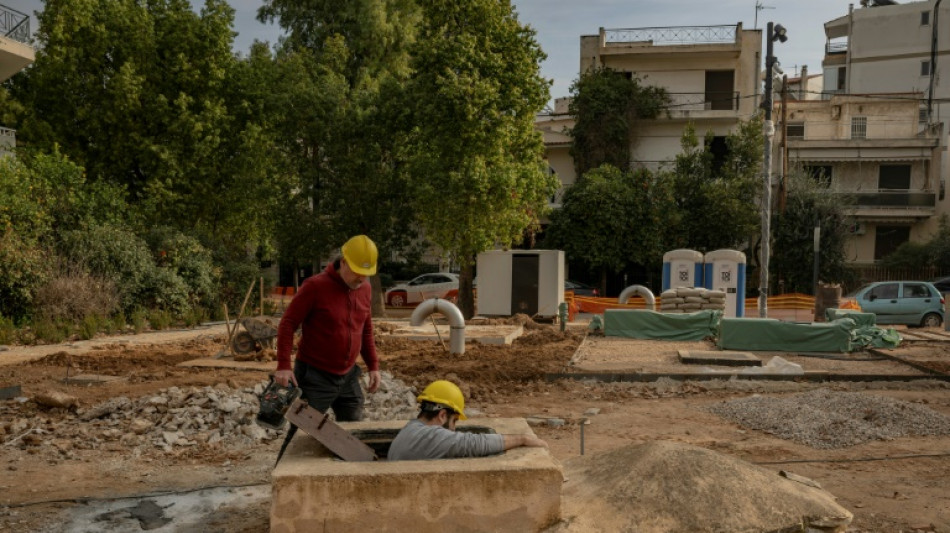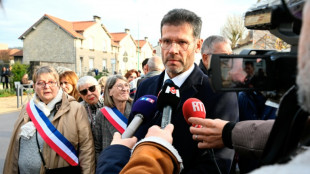
-
 Chileans vote in elections dominated by crime, immigration
Chileans vote in elections dominated by crime, immigration
-
Turkey seeks to host next COP as co-presidency plans falter

-
 Bezzecchi claims Valencia MotoGP victory in season-ender
Bezzecchi claims Valencia MotoGP victory in season-ender
-
Wasim leads as Pakistan dismiss Sri Lanka for 211 in third ODI

-
 Serbia avoiding 'confiscation' of Russian shares in oil firm NIS
Serbia avoiding 'confiscation' of Russian shares in oil firm NIS
-
Coach Gambhir questions 'technique and temperament' of Indian batters

-
 Braathen wins Levi slalom for first Brazilian World Cup victory
Braathen wins Levi slalom for first Brazilian World Cup victory
-
Rory McIlroy wins seventh Race to Dubai title

-
 Samsung plans $310 bn investment to power AI expansion
Samsung plans $310 bn investment to power AI expansion
-
Harmer stars as South Africa stun India in low-scoring Test

-
 Mitchell ton steers New Zealand to seven-run win in first Windies ODI
Mitchell ton steers New Zealand to seven-run win in first Windies ODI
-
Harmer stars as South Africa bowl out India for 93 to win Test

-
 China authorities approve arrest of ex-abbot of Shaolin Temple
China authorities approve arrest of ex-abbot of Shaolin Temple
-
Clashes erupt in Mexico City anti-crime protests, injuring 120

-
 India, without Gill, 10-2 at lunch chasing 124 to beat S.Africa
India, without Gill, 10-2 at lunch chasing 124 to beat S.Africa
-
Bavuma fifty makes India chase 124 in first Test

-
 Mitchell ton lifts New Zealand to 269-7 in first Windies ODI
Mitchell ton lifts New Zealand to 269-7 in first Windies ODI
-
Ex-abbot of China's Shaolin Temple arrested for embezzlement

-
 Doncic scores 41 to propel Lakers to NBA win over Bucks
Doncic scores 41 to propel Lakers to NBA win over Bucks
-
Colombia beats New Zealand 2-1 in friendly clash

-
 France's Aymoz wins Skate America men's gold as Tomono falters
France's Aymoz wins Skate America men's gold as Tomono falters
-
Gambling ads target Indonesian Meta users despite ban

-
 Joe Root: England great chases elusive century in Australia
Joe Root: England great chases elusive century in Australia
-
England's Archer in 'happy place', Wood 'full of energy' ahead of Ashes

-
 Luxury houses eye India, but barriers remain
Luxury houses eye India, but barriers remain
-
Budget coffee start-up leaves bitter taste in Berlin

-
 Reyna, Balogun on target for USA in 2-1 win over Paraguay
Reyna, Balogun on target for USA in 2-1 win over Paraguay
-
Japa's Miura and Kihara capture Skate America pairs gold

-
 Who can qualify for 2026 World Cup in final round of European qualifiers
Who can qualify for 2026 World Cup in final round of European qualifiers
-
UK to cut protections for refugees under asylum 'overhaul'

-
 England's Tuchel plays down records before final World Cup qualifier
England's Tuchel plays down records before final World Cup qualifier
-
Depoortere double helps France hold off spirited Fiji

-
 Scotland face World Cup shootout against Denmark after Greece defeat
Scotland face World Cup shootout against Denmark after Greece defeat
-
Hansen hat-trick inspires Irish to record win over Australia

-
 Alcaraz secures ATP Finals showdown with 'favourite' Sinner
Alcaraz secures ATP Finals showdown with 'favourite' Sinner
-
UK to cut protections for refugees under asylum 'overhaul': govt

-
 Spain, Switzerland on World Cup brink as Belgium also made to wait
Spain, Switzerland on World Cup brink as Belgium also made to wait
-
Sweden's Grant leads by one at LPGA Annika tournament

-
 Scotland cling to hopes of automatic World Cup qualification despite Greece defeat
Scotland cling to hopes of automatic World Cup qualification despite Greece defeat
-
Alcaraz secures ATP Finals showdown with great rival Sinner

-
 England captain Itoje savours 'special' New Zealand win
England captain Itoje savours 'special' New Zealand win
-
Wales's Evans denies Japan historic win with last-gasp penalty

-
 Zelensky renews calls for more air defence after deadly strike on Kyiv
Zelensky renews calls for more air defence after deadly strike on Kyiv
-
NBA's struggling Pelicans sack coach Willie Green

-
 Petain tribute comments raise 'revisionist' storm in France
Petain tribute comments raise 'revisionist' storm in France
-
Spain on World Cup brink as Belgium also made to wait

-
 Spain virtually seal World Cup qualification in Georgia romp
Spain virtually seal World Cup qualification in Georgia romp
-
M23, DR Congo sign new peace roadmap in Doha

-
 Estevao, Casemiro on target for Brazil in Senegal win
Estevao, Casemiro on target for Brazil in Senegal win
-
Ford steers England to rare win over New Zealand


Arid Athens turns to ancient aqueduct as climate crisis bites
Between parked cars in a suburban street in Athens, workers fix a pump to an ancient stone well that in turn accesses an aqueduct built almost 2,000 years ago.
The Greek capital, one of Europe's hottest and most densely populated cities, is going to great lengths -- and depths -- to battle soaring summer temperatures and creaking infrastructure.
Officials are tapping European Union money to help restore access to Hadrian's Aqueduct, a 24-kilometre (15-mile) underground channel named after the Roman emperor who funded its construction in the year 140.
It is hailed by experts as an "engineering marvel".
Last year, public utility company Eydap repeatedly warned Athenians they needed to save drinking water as reserves shrank.
Eydap's Katerina Apostolopoulou, who manages the project in the Chalandri suburb, around 10 kilometres from central Athens, said the water would not be of drinking quality and instead would be used "to clean or to irrigate parks and gardens" in summer.
She pointed out that Athenians would normally need to use the drinking water network for their gardens and parks, so she hoped the new pump would help save the valuable resource.
- War shelter -
The aqueduct, which begins at the foot of Mount Parnitha, is fed by an aquifer, explained geologist Yannis Dafnos.
A gentle slope from the mountain helps the water flow down naturally into the city centre.
The Chalandri well is more than 20 metres deep and part of a network of 300 ancient wells, Dafnos said as he lifted the heavy iron cover.
George Sachinis, Eydap's director of strategy and innovation, called the aqueduct an "archaeological and engineering marvel".
He urged planners to use it to create more green spaces in a city hit hard by the climate crisis.
"It is one of the most important ancient aqueducts in Europe," he said.
The aqueduct helped supply the city for hundreds of years but fell into disuse after the Roman era.
Athenians began to reuse it at the end of the 19th century but it was abandoned again after two dams were constructed near the city.
During the Nazi occupation (1941-1944) and then the ensuing Greek civil war, one of the Chalandri wells that it is now dry was used as a shelter, said Christos Giovanopoulos, who heads Cultural Hidrant, a heritage management project at Chalandri town hall.
The restoration project is part of "the promotion of sustainable development in Athens", he said, adding that water was often wasted.
- 'Collaborates with nature' -
He said the Chalandri project aimed to promote green spaces and improve the microclimate through water recycling, while highlighting the archaeological and cultural importance of the entire monument.
A few years ago, Chalandri residents had to zigzag to avoid the well, which at the time was located in the middle of the street, Giovanopoulos said.
Now, the northern Athens suburb will be the first of eight municipalities in the Athens region to benefit from the reuse of the aqueduct's water.
An adjacent dry well has been fitted with a ladder to allow visitors to descend and view parts of the ancient conduit.
The aqueduct eventually reaches the centre of Athens at the foot of Lycabettus Hill, once the site of a Roman reservoir.
Only a few parts of the original reservoir construction remain. The existing structure with stone columns and arches is largely a reconstruction from the nineteenth century.
At the very bottom, in the ancient canal, "a few parts of the roof built by the Romans to prevent rocks from falling into the aqueduct remain", Sachinis said.
"It is an elegant piece of infrastructure that respects and collaborates perfectly with nature," he said.
"Thanks to this aqueduct, there are plans to create more green space around the original reservoir", he added.
A.Suleiman--SF-PST




